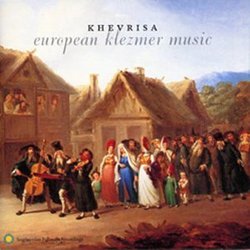| All Artists: Klezmer Traditional Title: Khevrisa European klezmer music Members Wishing: 2 Total Copies: 0 Label: Smithsonian Folkways Original Release Date: 4/25/2000 Release Date: 4/25/2000 Genres: Dance & Electronic, Folk, International Music, Classical Styles: Jewish & Yiddish, Europe, Continental Europe, Chamber Music, Historical Periods, Classical (c.1770-1830) Number of Discs: 1 SwapaCD Credits: 1 UPC: 093074048627 |
Search - Klezmer Traditional :: Khevrisa European klezmer music
 | Klezmer Traditional Khevrisa European klezmer music Genres: Dance & Electronic, Folk, International Music, Classical
|
Larger Image |
CD Details |
CD ReviewsBEAUTIFUL KLEZMER FIDDL E & HAMMER DULCIMER MUSIC Shlomo Pestcoe | 08/30/2000 (5 out of 5 stars) "Nowadays, when we think of klezmer-- the traditional instrumental music of the Ashkenazim (Yiddish-speaking Central and Eastern European Jewry)-- the main instrument that comes to mind is the clarinet. When we listen to the classic klezmer 78 rpm recordings from the first half of the 20th century, it's the wailing clarinet that stands out and leads the rest of the kapelye (klezmer ensemble). And it's the recorded legacy of the great early clarinetists-- Dave Tarras, Naftule Brandwein and Shloimke Beckerman, to name but a few-- that serves as the primary source and reference for most of today's klezmer musicians.Yet, in recent years, there's has been a resurgence of interest in the older forms of klezmer, which were centered around the fidl(violin) and the tsmibl (hammer dulcimer). Beginning in the 1600s, up until the ascendency of the clarinet and military brass band instruments sometime in the late 19th century, the typical kaplye consisted of fidl, backed by a tsmibl and bowed bass or cello, occasionally augmented by a wooden transverse flute. If there were several fiddlers, the "ershter" (first violin) would play lead while the "tsveyter" (second violin) harmonizes in the lower register or plays a "secunda" rhythmic chordal accompaniment (standard practice in all forms of traditional fiddle music, regardless of ethnicity and region).This album's title KHEVRISA is a Yiddish term which usually refers to a talmudic study group. Back in the Old World, klezmorim adopted it into their slang as another reference for a music group. In this case, both definitions are very appropriate: the chevrei (group members), led by the pioneering scholarship of Walter Zev Feldman, have pooled their own personal, extensive research into early klezmer traditions and their exceptional musical abilities to do this project. The result is a wonderful album of incredibly beautiful music-- unique, as the only modern klezmer recording to date that's devoted exclusively to traditional stringed instruments. It's supported by one of the best CD booklets I've ever encountered. Zev, one of the foremost authorities on Near Eastern, Balkan and klezmer music, has outdone himself on the amazingly comprehensive liner notes.KHEVRISA's line-up reads like a "Who's Who" of the current klezmer revival's leading musician: Steven Greenman (ershter fidl), who was lead fiddler for BUDOWITZ, another excellent modern group devoted to 19th century klezmer music; Walter Zev Feldman (tsmibl), one of the pioneers of the klezmer revival; Alicia Svigals (tsveyter fidl), fiddler for the KLEZMATICS, one of today's hottest bands; Michael Alpert (sekunda fidl), fiddler/vocalist for BRAVE OLD WORLD, who studied with Leon Schwartz (1901-1990), one of the last tradition-bearers of the old European klezmer fiddle tradition; and Stuart Brotman (bass), who plays bass and tsimbl for BRAVE OLD WORLD, a world-class group that performs both traditional and modern klezmer music. One note: those expecting the typical "tumeldik" (rowdy) freilachs may be disappointed -- the approach here is more chamber orchestra than dance band. Violinist Steve Greenman, while a "serious performer of Hungarian Nota, Romanian Gypsy, and Slovak music" in addition to klezmer, comes from a classical music background. This is very apparent in his very tight, smooth-like-glass performance style. Actually, Steve's classical sound has more in common with the conservatory-trained Eastern European "folk" violinists of today, than with the traditional fiddlers of the past that he's attempting to emulate. Even still, his use of "krechts" (lit. "cries") and other traditional melodic ornamentation is spot-on, while, overall, the group's thoughtful musical arrangements convey a "ma'mahsh Yiddishe tam" (genuine Jewish flavor). Taking all this into consideration, I heartily recommend this CD as one of the finest albums to come out of the klezmer revival."
|

 Track Listings (20) - Disc #1
Track Listings (20) - Disc #1